Collaborative Approaches for Cyber Security in Cyber-Physical Systems, no. Part of the Advanced Sciences and Technologies for Security Applications book series (ASTSA), Springer, pp. 145-170, 01/2023. DOI

37th International Conference on ICT Systems Security and Privacy Protection – IFIP SEC 2022, Springer, pp. 215-230, 06/2022. DOI

36th Annual IFIP WG 11.3 Conference on Data and Applications Security and Privacy (DBSec'22), vol. 13383, Springer, pp. 183-194, 07/2022. DOI
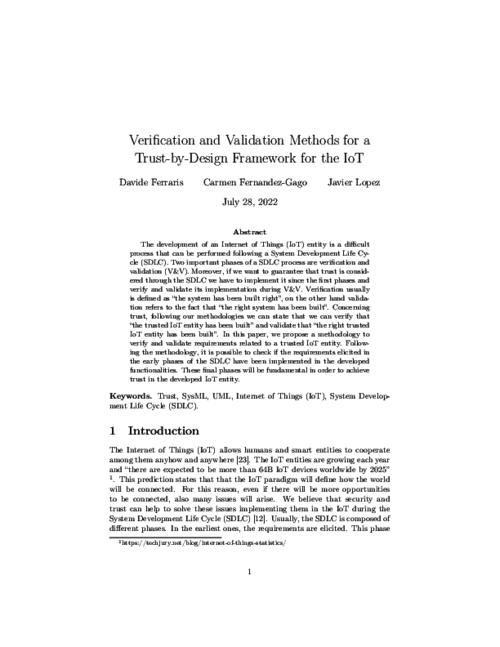
Human-centric Computing and Information Sciences, vol. 10, no. 50, Springer, 12/2020. DOI
Abstract
The Internet of Things (IoT) is a paradigm that permits smart entities to be interconnected anywhere and anyhow. IoT opens new opportunities but also rises new issues.
In this dynamic environment, trust is useful to mitigate these issues. In fact, it is important that the smart entities could know and trust the other smart entities in order to collaborate with them.
So far, there is a lack of research when considering trust through the whole System Development Life Cycle (SDLC) of a smart IoT entity.
In this paper, we suggest a new approach that considers trust not only at the end of the SDLC but also at the start of it. More precisely, we explore the modeling phase proposing a model-driven approach extending UML and SysML considering trust and its related domains, such as security and privacy.
We propose stereotypes for each diagram in order to give developers a way to represent trust elements in an effective way.
Moreover, we propose two new diagrams that are very important for the IoT: a traceability diagram and a context diagram.
This model-driven approach will help developers to model the smart IoT entities according to the requirements elicited in the previous phases of the SDLC.
These models will be a fundamental input for the following and final phases of the SDLC.
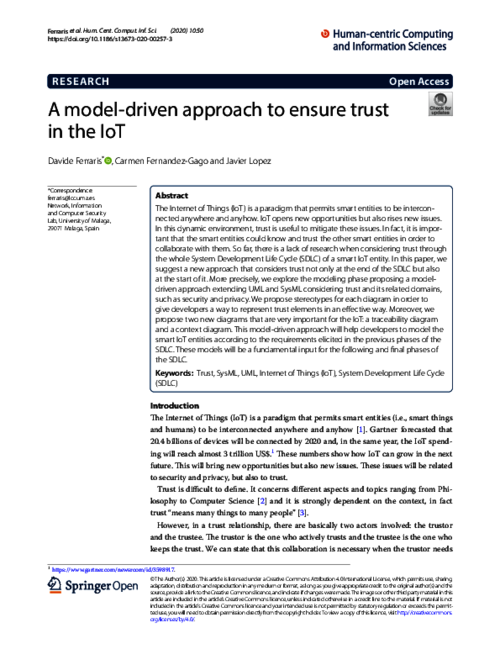
International Journal of Information Security, Springer, 2020. DOI
Abstract
Nowadays, smart home devices like Amazon Echo and Google Home have reached mainstream popularity.
Being in the homes of users, these devices are intrinsically intrusive, being able to access details such as users' name, gender, home address, calendar appointments and others.
There are growing concerns about indiscriminate data collection and invasion of user privacy in smart home devices, but studies show that perceived benefits are exceeding perceived risks when it comes to consumers.
As a result, consumers are placing a lot of trust in these devices, sometimes without realizing it.
Improper trust assumptions and security controls can lead to unauthorized access and control of the devices, which can result in serious consequences.
In this paper, we explore the behaviour of devices such as Amazon Echo and Google Home in a smart home setting with respect to trust relationships and propose a trust model to improve these relationships among all the involved actors.
We have evaluated how trust was built and managed from the initial set up phase to the normal operation phase, during which we performed a number of interaction tests with different types of users (i.e. owner, guests).
As a result, we were able to assess the effectiveness of the provided security controls and identify potential relevant security issues. In order to address the identified issues, we defined a trust model and propose a solution based on it for further securing smart home systems.
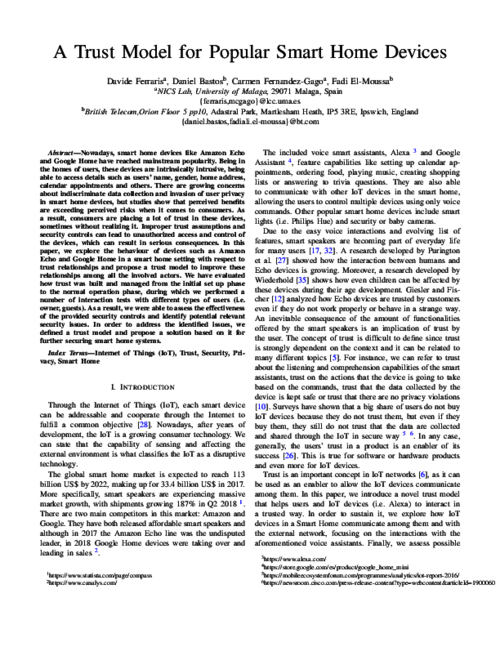
The 20th World Conference on Information Security Applications: WISA-Workshop 2019, Springer, 2019.
Abstract
In recent times, smart home devices like Amazon Echo and Google Home have reached mainstream popularity. These devices are intrinsically intrusive, being able to access user’s personal information. There are growing concerns about indiscriminate data collection and invasion of user privacy in smart home devices. Improper trust assumptions and security controls can lead to unauthorized access of the devices, which can have severe consequences (i.e. safety risks). In this paper, we analysed the behaviour of smart home devices with respect to trust relationships. We set up a smart home environment to evaluate how trust is built and managed. Then, we performed a number of interaction tests with different types of users (i.e. owner, guests). As a result, we were able to assess the effectiveness of the provided security controls and identify some relevant security issues. To address them, we defined a trust model and proposed a solution based on it for securing smart home devices.
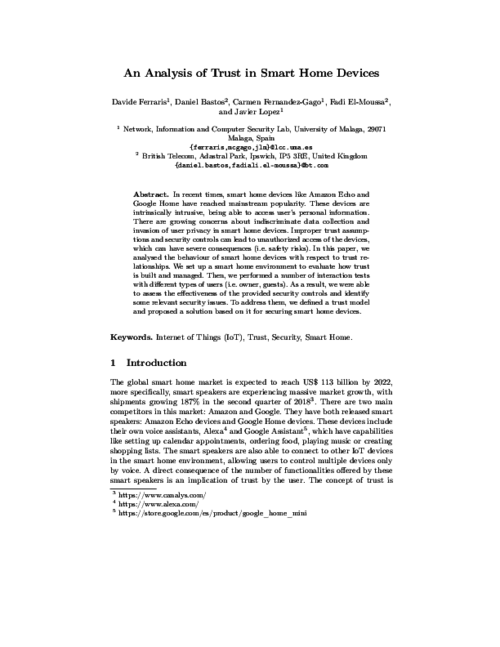
IEEE Consumer Communications & Networking Conference 2019, IEEE, 03/2019. DOI
Abstract
With the ever-increasing number of smart home devices, the issues related to these environments are also growing. With an ever-growing attack surface, there is no standard way to protect homes and their inhabitants from new threats. The inhabitants are rarely aware of the increased security threats that they are exposed to and how to manage them. To tackle this problem, we propose a solution based on segmented architectures similar to the ones used in industrial systems. In this approach, the smart home is segmented into various levels, which can broadly be categorised into an inner level and external level. The external level is protected by a firewall that checks the communication from/to the Internet to/from the external devices. The internal level is protected by an additional firewall that filters the information and the communications between the external and the internal devices. This segmentation guarantees a trusted environment between the entities belonging to the internal network. In this paper, we propose an adaptive trust model that checks the behaviour of the entities and, through this model, in case the entities violate trust rules they can be put in quarantine or banned from the network.

International Journal of Information Security , Springer, pp. 111-127, 01/2020, 2019. DOI
Abstract
The Internet of Things (IoT) is an environment of interconnected entities, which are identifiable, usable and controllable via the Internet. Trust is useful for a system such as the IoT as the entities involved would like to know how the other entities they have to interact with are going to perform.
When developing an IoT entity, it will be desirable to guarantee trust during its whole life cycle. Trust domain is strongly dependent on other domains such as security and privacy.
To consider these domains as a whole and to elicit the right requirements since the first phases of the System Development Life Cycle (SDLC) is a key point when developing an IoT entity.
This paper presents a requirements elicitation method focusing on trust plus other domains such as security, privacy and usability that increase the trust level of the IoT entity developed. To help the developers to elicit the requirements, we propose a JavaScript Notation Object (JSON) template containing all the key elements that must be taken into consideration.
We emphasize on the importance of the concept of traceability. This property permits to connect all the elicited requirements guaranteeing more control on the whole requirements engineering process.
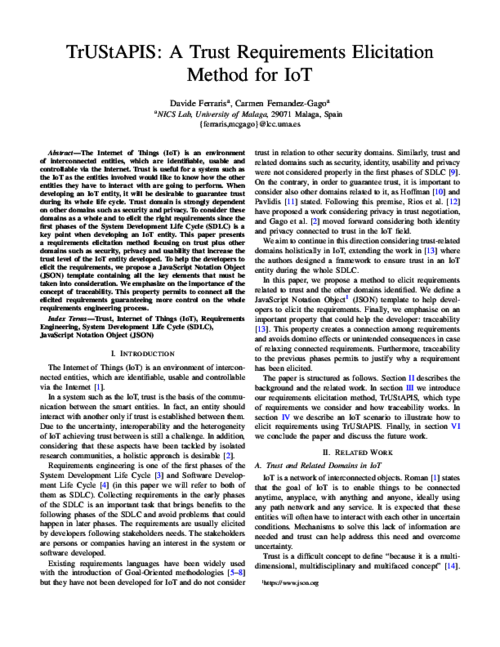
2018 9th IFIP International Conference on New Technologies Mobility and Security (NTMS), IEEE, 04/2018. DOI
Abstract
The Internet of Things (IoT) is an environment of interconnected entities, that are identifiable, usable and controllable via the Internet. Trust is necessary in a system such as IoT as the entities involved should know the effect of interacting with other entities. Moreover, the entities must also be able to trust a system to reliably use it. An IoT system is composed of different entities from different vendors, each of them with a different purpose and a different lifecycle. So considering trust in the whole IoT system lifecycle is useful and necessary to guarantee a good service for the whole system. The heterogeneity and dynamicity of this field make it difficult to ensure trust in IoT. We propose a trust by design framework for including trust in the development of an IoT entity considering all the phases of the life-cycle. It is composed of the K-Model and transversal activities.
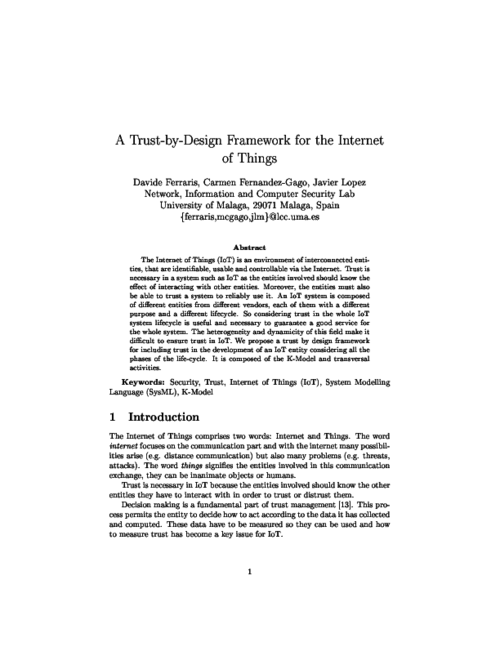
 ]
]